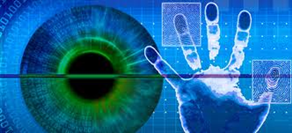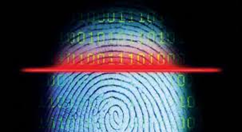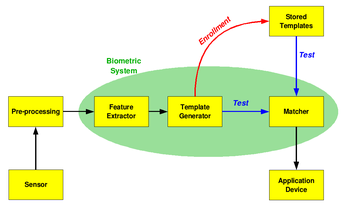 ®
®
Biometrics refers to metrics related to human characteristics and traits. Biometrics identification (or biometric authentication) is used in computer science as a form of identification and access control. It is also used to identify individuals in groups that are under surveillance.


Biometric identifiers are the distinctive, measurable characteristics used to label and describe individuals. Biometric identifiers are often categorized as physiological versus behavioral characteristics. Physiological characteristics are related to the shape of the body. Examples include, but are not limited to fingerprint, palm veins, face recognition, DNA, palm print, hand geometry, iris recognition, retina and odour/scent. Behavioral characteristics are related to the pattern of behavior of a person, including but not limited to typing rhythm, gait, and voice. Some researchers have coined the term behaviometrics to describe the latter class of biometrics.
More traditional means of access control include token-based identification systems, such as a driver's license or passport, and knowledge-based identification systems, such as a password or personal identification number.[2] Since biometric identifiers are unique to individuals, they are more reliable in verifying identity than token and knowledge-based methods; however, the collection of biometric identifiers raises privacy concerns about the ultimate use of this information.
Many different aspects of human physiology, chemistry or behavior can be used for biometric authentication. The selection of a particular biometric for use in a specific application involves a weighting of several factors. Jain et al. (1999) identified seven such factors to be used when assessing the suitability of any trait for use in biometric authentication. Universality means that every person using a system should possess the trait. Uniqueness means the trait should be sufficiently different for individuals in the relevant population such that they can be distinguished from one another. Permanence relates to the manner in which a trait varies over time. More specifically, a trait with 'good' permanence will be reasonably invariant over time with respect to the specific matching algorithm. Measurability (collectability) relates to the ease of acquisition or measurement of the trait. In addition, acquired data should be in a form that permits subsequent processing and extraction of the relevant feature sets. Performance relates to the accuracy, speed, and robustness of technology used. Acceptability relates to how well individuals in the relevant population accept the technology such that they are willing to have their biometric trait captured and assessed. Circumvention relates to the ease with which a trait might be imitated using an artifact or substitute.
No single biometric will meet all the requirements of every possible application.

The block diagram illustrates the two basic modes of a biometric system. First, in verification (or authentication) mode the system performs a one-to-one comparison of a captured biometric with a specific template stored in a biometric database in order to verify the individual is the person they claim to be. Three steps are involved in the verification of a person. In the first step, reference models for all the users are generated and stored in the model database. In the second step, some samples are matched with reference models to generate the genuine and impostor scores and calculate the threshold. Third step is the testing step. This process may use a smart card, username or ID number (e.g. PIN) to indicate which template should be used for comparison. 'Positive recognition' is a common use of the verification mode, "where the aim is to prevent multiple people from using same identity".
Second, in identification mode the system performs a one-to-many comparison against a biometric database in attempt to establish the identity of an unknown individual. The system will succeed in identifying the individual if the comparison of the biometric sample to a template in the database falls within a previously set threshold. Identification mode can be used either for 'positive recognition' (so that the user does not have to provide any information about the template to be used) or for 'negative recognition' of the person "where the system establishes whether the person is who she (implicitly or explicitly) denies to be". The latter function can only be achieved through biometrics since other methods of personal recognition such as passwords, PINs or keys are ineffective.
The first time an individual uses a biometric system is called enrollment. During the enrollment, biometric information from an individual is captured and stored. In subsequent uses, biometric information is detected and compared with the information stored at the time of enrollment. Note that it is crucial that storage and retrieval of such systems themselves be secure if the biometric system is to be robust. The first block (sensor) is the interface between the real world and the system; it has to acquire all the necessary data. Most of the times it is an image acquisition system, but it can change according to the characteristics desired. The second block performs all the necessary pre-processing: it has to remove artifacts from the sensor, to enhance the input (e.g. removing background noise), to use some kind of normalization, etc. In the third block necessary features are extracted. This step is an important step as the correct features need to be extracted in the optimal way. A vector of numbers or an image with particular properties is used to create a template. A template is a synthesis of the relevant characteristics extracted from the source. Elements of the biometric measurement that are not used in the comparison algorithm are discarded in the template to reduce the file size and to protect the identity of the enrollee.
enrollment. Note that it is crucial that storage and retrieval of such systems themselves be secure if the biometric system is to be robust. The first block (sensor) is the interface between the real world and the system; it has to acquire all the necessary data. Most of the times it is an image acquisition system, but it can change according to the characteristics desired. The second block performs all the necessary pre-processing: it has to remove artifacts from the sensor, to enhance the input (e.g. removing background noise), to use some kind of normalization, etc. In the third block necessary features are extracted. This step is an important step as the correct features need to be extracted in the optimal way. A vector of numbers or an image with particular properties is used to create a template. A template is a synthesis of the relevant characteristics extracted from the source. Elements of the biometric measurement that are not used in the comparison algorithm are discarded in the template to reduce the file size and to protect the identity of the enrollee existing templates, estimating the distance between them using any algorithm (e.g. Hamming distance). The matching program will analyze the template with the input. This will then be output for any specified use or purpose (e.g. entrance in a restricted area. Selection of biometrics in any practical application depending upon the characteristic measurements and user requirements. We should consider Performance, Acceptability, Circumvention, Robustness, Population coverage, Size, Identity theft deterrence in selecting a particular biometric. Selection of biometric based on user requirement considers Sensor availability, Device availability, Computational time and reliability, Cost, Sensor area and power consumption.
Multimodal biometric systems use multiple sensors or biometrics to overcome the limitations of unimodal biometric systems. For instance iris recognition systems can be compromised by aging irides and finger scanning systems by worn-out or cut fingerprints. While unimodal biometric systems are limited by the integrity of their identifier, it is unlikely that several unimodal systems will suffer from identical limitations. Multimodal biometric systems can obtain sets of information from the same marker (i.e., multiple images of an iris, or scans of the same finger) or information from different biometrics (requiring fingerprint scans and, using voice recognition, a spoken pass-code). Multimodal biometric systems can integrate these unimodal systems sequentially, simultaneously, a combination thereof, or in series, which refer to sequential, parallel, hierarchical and serial integration modes, respectively. Broadly, the information fusion is divided into three parts, pre-mapping fusion, midst-mapping fusion, and post-mapping fusion/late fusion. In pre-mapping fusion information can be combined at sensor level or feature level. Sensor-level fusion can be mainly organized in three classes: (1) single sensor-multiple instances, (2) intra-class multiple sensors, and (3) inter-class multiple sensors. Feature-level fusion can be mainly organized in two categories: (1) intra-class and (2) inter-class. Intra-class is again classified into four subcategories: (a) Same sensor-same features, (b) Same sensor-different features, (c) Different sensors-same features, and (d) Different sensors-different features.
The following are used as performance metrics for biometric systems:
The earliest cataloging of fingerprints dates back to 1891 when Juan Vucetich started a collection of fingerprints of criminals in Argentina. The History of Fingerprints.
Adaptive biometric Systems aim to auto-update the templates or model to the intra-class variation of the operational data. The two-fold advantages of these systems are solving the problem of limited training data and tracking the temporal variations of the input data through adaptation. Recently, adaptive biometrics have received a significant attention from the research community. This research direction is expected to gain momentum because of their key promulgated advantages. First, with an adaptive biometric system, one no longer needs to collect a large number of biometric samples during the enrollment process. Second, it is no longer necessary to re-enroll or retrain the system from scratch in order to cope with the changing environment. This convenience can significantly reduce the cost of maintaining a biometric system. Despite these advantages, there are several open issues involved with these systems. For mis-classification error (false acceptance) by the biometric system, cause adaptation using impostor sample. However, continuous research efforts are directed to resolve the open issues associated to the field of adaptive biometrics. More information about adaptive biometric systems can be found in the critical review by Rattani et al.
India's national ID program
India's national ID program called Aadhaar is the largest biometric database of the world. It is a biometrics-based digital identity assigned for lifetime, verifiable online instantly in public domain, at any time, from anywhere, in a paperless way. It is designed to enable government agencies to deliver retail public service securely based on biometric data (fingerprint, iris scan and face photo), along with demographic data (name, age, gender, address, parent/spouse name, mobile phone number) of a person. The data is transmitted in encrypted form over internet for authentication, aiming to free it from limitations of physical presence of a person at a given place.
It has enrolled about 550 million residents and assigned 480 million Aadhaar numbers as of 7 November 2013. It aims to cover entire population of 1.25 billion in a few years.
In recent times, biometrics based on brain (electroencephalogram) and heart (electrocardiogram) signals have emerged. The research group at University of Wolverhampton led by Ramaswamy Palaniappan has shown that people have certain distinct brain and heart patterns that are specific for each individual. The advantage of such 'futuristic' technology is that it is more fraud resistant compared to conventional biometrics like fingerprints. However, such technology is generally more cumbersome and still has issues such as lower accuracy and poor reproducibility over time.
A basic premise in the above proposal is that the person that has uniquely authenticated themselves using biometrics with the computer is in fact also the agent performing potentially malicious actions from that computer. However, if control of the computer has been subverted, for example in which the computer is part of a botnet controlled by a hacker, then knowledge of the identity of the user at the terminal does not materially improve network security or aid law enforcement activities.
Recently, another approach to biometric security was developed, this method scans the entire body of prospects to guarantee a better identification of this prospect. This method is not globally accepted because it is very complex and prospects are concerned about their privacy.
Privacy and discrimination
It is possible that data obtained during biometric enrollment may be used in ways for which the enrolled individual has not consented. For example, biometric security that utilizes an employee's DNA profile could also be used to screen for various genetic diseases or other 'undesirable' traits.
There are three categories of privacy concerns:
When thieves cannot get access to secure properties, there is a chance that the thieves will stalk and assault the property owner to gain access. If the item is secured with a biometric device, the damage to the owner could be irreversible, and potentially cost more than the secured property.
For example, in 2005, Malaysian car thieves cut off the finger of a Mercedes-Benz S-Class owner when attempting to steal the car.
One advantage of passwords over biometrics is that they can be re-issued. If a token or a password is lost or stolen, it can be cancelled and replaced by a newer version. This is not naturally available in biometrics. If someone's face is compromised from a database, they cannot cancel or reissue it. Cancelable biometrics is a way in which to incorporate protection and the replacement features into biometrics. It was first proposed by Ratha et al.
Several methods for generating new exclusive biometrics have been proposed. The first fingerprint-based cancelable biometric system was designed and developed by Tulyakov et al. Essentially, cancelable biometrics perform a distortion of the biometric image or features before matching. The variability in the distortion parameters provides the cancelable nature of the scheme. Some of the proposed techniques operate using their own recognition engines, such as Teoh et al. and Savvides et al., whereas other methods, such as Dabbah et al., take the advantage of the advancement of the well-established biometric research for their recognition front-end to conduct recognition. Although this increases the restrictions on the protection system, it makes the cancellable templates more accessible for available biometric technologies.
Soft biometrics traits are physical, behavioral or adhered human characteristics, which have been derived from the way human beings normally distinguish their peers (e.g. height, gender, hair color). Those attributes have a low discriminating power, thus not capable of identification performance; additionally they are fully available to everyone which makes them privacy-safe.
Many countries, including the United States, are planning to share biometric data with other nations.
In testimony before the US House Appropriations Committee, Subcommittee on Homeland Security on "biometric identification" in 2009, Kathleen Kraninger and Robert A Mocny commented on international cooperation and collaboration with respect to biometric data, as follows:
To ensure we can shut down terrorist networks before they ever get to the United States, we must also take the lead in driving international biometric standards. By developing compatible systems, we will be able to securely share terrorist information internationally to bolster our defenses. Just as we are improving the way we collaborate within the U.S. Government to identify and weed out terrorists and other dangerous people, we have the same obligation to work with our partners abroad to prevent terrorists from making any move undetected. Biometrics provide a new way to bring terrorists’ true identities to light, stripping them of their greatest advantage—remaining unknown.
According to an article written in 2009 by S. Magnuson in the National Defense Magazine entitled "Defense Department under Pressure to Share Biometric Data" the United States has bi-lateral agreements with other nations aimed at sharing biometric data. To quote that article:
Miller [a consultant to the Office of Homeland Defense and America's security affairs] said the United States has bi-lateral agreements to share biometric data with about 25 countries. Every time a foreign leader has visited Washington during the last few years, the State Department has made sure they sign such an agreement.
Certain members of the civilian community are worried about how biometric data is used but full disclosure may not be forthcoming. In particular, the Unclassified Report of the Defense Science Board Task Force on Defense Biometrics states that it is wise to protect, and sometimes even to disguise, the true and total extent of national capabilities in areas related directly to the conduct of security-related activities. This also potentially applies to Biometrics. It goes on to say that this is a classic feature of intelligence and military operations. In short, the goal is to preserve the security of 'sources and methods'.
Main article: Countries applying biometrics
Countries using biometrics include Australia, Brazil, Canada, Gambia, Germany, India, Iraq, Israel, Italy, Netherlands, New Zealand, Norway, Ukraine, United Kingdom, and United States.
Among low-middle income countries, roughly 1.2 billion people have already received identification through a biometric identification program.
 ®
®